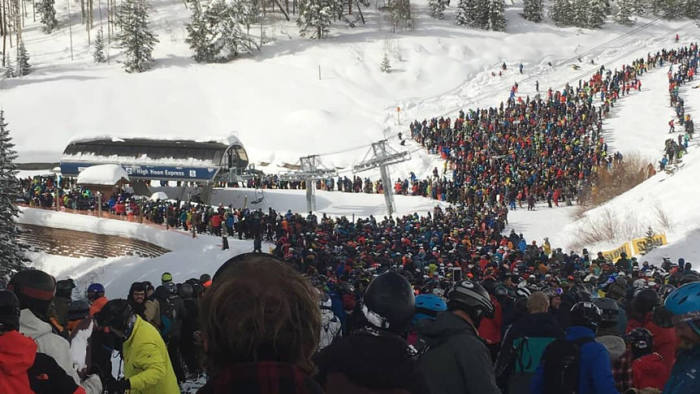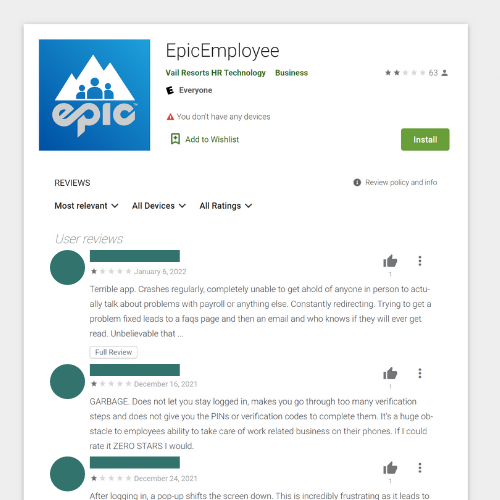It was a tough 2021-2022 season at many Vail resorts.

If you bought an Epic Pass this year, you may have ended up disappointed. Many skiers were met with large crowds, overflowing parking lots, closed lifts and lift lines stretching almost comically long.
Staffing issues in dining areas also led to long lines and major crowds in lodges and restaurants. Many irate passholders took to social media to express their disdain for the large ski resort conglomerate. The Epic Lift Lines Instagram page showcases some of the long lines from this season, and some hilarious memes about the staffing and overcrowding issues at Vail Resorts.
Who or what is to blame for Vail’s train-wreck of a season? Is it the skiing masses, eager to return to the snow after COVID-19 put a damper on the past 2 seasons? Is it the lack of proper staffing? The overselling of passes? Greedy resort owners putting money first and experience last?
All of these factors likely contributed to the logistical nightmare of a season at many Vail resorts this year, but understaffing, and a lack of appreciation for their talented workers, seems to be at greatest fault.
Oversold Passes?
For the 2021-2022 season, Vail resorts sold a record 2.1 million Epic Passes, a 76% increase since the 2019-2020 season. Since so many indoor activities were unavailable or unsafe during the pandemic, many turned to outdoor activities like skiing to stay active, stay busy, or stay sane.

Vail slashed the price of its Epic pass by 20% this season. The drop in price coupled with many skiers’ new or renewed interest in the sport likely led to the incredible increase in passes sold.
When Vail sells the Epic pass, they factor in how many people will be using that pass on any given day and at any given mountain, in order to determine how many day-tickets to sell and how to properly staff the mountain. On some of the busiest days early this season, there was clearly a miscalculation here.
A mountain can stop selling day tickets whenever it wants to. Many Vail resorts announced months in advance that no day tickets would be available for peak days like December 27 through January 1.
However, once they have sold a season pass or a multi-pass, they have no real way to control how many passholders will show up on a given day. When you buy a pass, you are paying for the ability to ski if you would like to on any day, certain days of the week, or a certain number of days. Resorts can’t in good taste (or publicity) deny passholders their day on the hill, even if they all decide to show up on the same day.
This miscalculation can lead to a busy day on the mountain, but what happened at some Vail resorts this season had other contributing factors. On its own, the record number of passes sold would likely lead to some very busy days and long lift lines, but would be unlikely to cause lift lines that stretch into parking lots or many of the other issues seen this season.
On its surface, dropping pass prices and selling more is a good thing! Most skiers want to see more people engage with skiing (or snowboarding), and cheaper passes make skiing more accessible for young adults, students, and people who don’t own a second home on the resort. This is, at its core, a good thing.
Additionally, Vail did crunch the numbers before selling so many passes. Statistically, ski resort visits have not gone up dramatically in the past few years, so the number of people skiing on any given day was likely not the main source of the perceived intense crowds. Overselling passes was not Vail Resorts’ biggest blunder, understaffing was.
Who works at ski resorts?
Staffing ski resorts has always been a hard task. Ski resorts are often located in the middle of nowhere. Housing costs near major ski areas also tend to be very high due to demand, so it can be hard to find somewhere to live even if you do want to move to a rural corner of your state to work at a ski resort.
Ski resorts also pay pretty low, especially for jobs that require specific skills– like operating a ski lift, groomer or snow maker, or teaching people how to ski. The hours can be brutal– you work weekends and holidays, early mornings too.
For snow makers and groomers, you often have to work overnight in the freezing cold to make sure the mountain is ready for the next day. It is also a seasonal job with potentially inconsistent hours, meaning you may not be able to get benefits like health insurance.
Most people who work at ski resorts do so out of their passion for the sport. While resort pay is low, benefits like a free season pass and discounts on food and equipment can help sweeten the deal for passionate skiers.
So that’s the pool of people ski resorts need to recruit: passionate skiers who can get paid almost nothing and still afford to live in some of the most expensive areas, who also have a car for going to a nearby town when they need essentials not available in the resort.
They should also have open availability, not mind missing out on family time over the holidays, and enjoy waking up at or before 6:00AM to go stand out in freezing temperatures for 8 hours or more, after walking up to the base area from the employee parking lot, approximately one mile away.
The Struggle to Staff
With this picture in mind, it is easy to see why ski resorts have so much difficulty with staffing. Thank a liftie, and tip your instructors! Many resorts have increased wages this season, which helps a bit, but raising wages from $10 to $15 an hour in expensive areas like resort towns is not even keeping up with inflation. A free season pass is a great perk, but you can’t eat it, and it doesn’t pay the rent.
Many ski resorts also rely on international hires, usually through the J1 visa program, to staff restaurants, lodges, hotels, lifts and more. J1 is a cultural exchange program that brings international workers and students to the US for seasonal jobs as visitors to the country. It was suspended for the 2020-2021 season due to the COVID-19 pandemic, but was reinstated for 2022.
While having J1 as an option definitely helped resorts get more staff this season, there were limitations. Workers had to have the right vaccine to enter the US, and there were a lot more hurdles than there were pre-Covid.

Housing has been a major issue for resort staffing this year and in recent years. Especially in the west, ski resorts are often far away from any other established towns, and housing in the resort towns is inflated to an incredible degree. This year especially, the pandemic’s effects on the real estate market has served to further drive up already inflated housing costs.
Vail Resorts also slashed middle-management and replaced human resource departments at all their resorts with a 1.6 star app, which definitely did not help them attract or retain talented staff, or keeping the staff they had.
In an attempt to deal with the housing issues, Vail reportedly stacked apartments with bunk beds so they could stuff 4+ employees into a small apartment.
These factors, coupled with COVID-19 concerns around working in a high contact industry like hospitality, have led to severe staffing shortages at many Vail (and non-Vail) ski resorts this year.
The effects of chronic understaffing
Without enough lift attendants, many lifts remained closed despite having skiable terrain to access from them. Not having enough lift attendants can also let lift lines become unorganized, leading to longer wait times and less efficiency getting the chairlift running at max capacity. Some mountains asked ski instructors to help fill the gaps in lift operation, which was helpful, but NOT a long-term or perfect solution.
Many mountains were severely restricted their operating hours due to not having enough people to keep lifts running. This further condenses all the people who want to go skiing into a shorter window of time.
Fewer open lifts mean less terrain is accessible, meaning the trails will be more crowded too. Shortage in snowmakers and groomers also cuts down on the terrain available for people to ski.
Under-staffed base lodges lead to longer lines at the cafeteria and more general chaos in the lodge. Dining locations were also forced to reduce their hours, leaving more skiers trying to cram into the lodge during shorter windows.
Compressing a record number of pass holders onto fewer lifts, less terrain and into shorter windows of time has led to a truly chaotic season at many Vail resorts. Hopefully, by raising wages and realizing the true value of quality employees, Vail Resorts can learn their lessons from this season and come back next year with more respect for their workers and a better season for passholders.